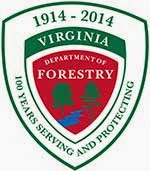Forest Influences and Programs
New infestations of the emerald ash borer (EAB) were detected in July in Fairfax County in three separate locations spanning the breadth of the County. The source of these infestations could not be determined. Fairfax and adjacent counties and municipalities (Fauquier, Prince William, Loudoun, Arlington, Manassas, Manassas Park) were quarantined by the Virginia Department of Agriculture and Consumer Services. It appears the infestations are some years old, making it likely EAB has spread to other locations that are as of yet undetected.

Gypsy Moth
Scattered moderate to heavy infestations have appeared this year, with state-wide defoliation totaling 112,343 acres, over 82,000 acres of which were on National Forest land. These scattered infestations were present in 20 counties from Northern Virginia down the Appalachians and scattered pockets of the Blue Ridge to the Blacksburg-Roanoke area. A vast area of over 42,000 acres covered the northwest and southwest corner of Augusta and Rockingham counties, respectively, most of which was within the George Washington National Forest. Tree mortality is likely after this second year of defoliation for many locations. Some areas have seen their third or fourth successive year of heavy defoliation.

Southern pine beetle (SPB) numbers remain low in most places based on the spring trapping survey results and relatively few reports. A few hotspot areas during the last couple of years seemed to have stabilized somewhat. In total, 26 spots amounting to 1,078 trees (average 41 trees per spot) acres across 9 counties were detected. No spots were reported on federal land and no counties were in outbreak status. Affected counties were concentrated in the south-central Piedmont or southwestern Coastal Plain and included Accomack, Amelia, Caroline, Chesterfield, Cumberland, Goochland, Greensville, Halifax and Nottoway Counties. The Virginia Department of Forestry has implemented a Southern Pine Beetle Prevention Program with federal funding and support which focuses on thinning pine stands to reduce hazard and provides cost-share assistance to landowners.
The hemlock wooly adelgid continues to cause significant hemlock decline in many areas, although trees in some areas that have supported infestations for many years are still hanging on. Despite the continued spread into most areas of the range in Virginia, hemlock mortality levels have stabilized over the last five years. The release of predators of the adelgid is on-going in Virginia and other states and offers some long-term hope of reducing the impacts of the adelgid on the hemlock resource.
A widespread outbreak of tulip tree scale continued for a second year along the eastern slopes of the Blue Ridge Mountains in Nelson County. Due to drought and early leaf senescence, it was difficult to accurately assess the extent of damage, but it probably spanned thousands of acres. An accurate assessment from aerial surveys was attempted in the spring but, with the exception of two large clearcuts in response to the outbreak, it was difficult to see damage from the air.
An unusual hail storm occurred on June 16th in the northern Piedmont that was so intense that roads quickly become covered in ice and snow plows had to be brought out. Moderate to severe damage occurred on scattered trees over an area of 27,000 acres. This damage was surveyed aerially. See November, 2008 Virginia Forest Health Review.
Oak and other hardwood decline continues to be widespread throughout the Commonwealth due to drought and past storm events. After an unusually high incidence of oak decline in the Coastal Plain during 2005, particularly among yard and landscape trees, decline and mortality continued but leveled off significantly. It is thought that accumulated stress due to the drought of 1998-2002 followed by the flooding rains, storms and hurricanes of the 2003-2004 season lead to unusually heavy decline, particularly among upland oak species in flood-prone areas. These widespread stress factors led to tree mortality precipitated by numerous biotic agents, including Armillaria, Hypoxylon canker, ambrosia beetles, two-lined chestnut borer, oak carpenter worm, and red-oak borer. This mortality has continued through 2008 and has been likely exacerbated in some areas by severe drought conditions this year and during the past three years. The most recent FIA survey data did in fact detect a net loss of hardwood volume in the southeast corner of Virginia.



